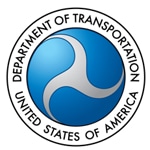Rule will make significant and extensive changes to improve accident prevention, mitigation and emergency response
 WASHINGTON – U.S. Transportation Secretary Anthony Foxx today announced a final rule for the safe transportation of flammable liquids by rail. The final rule, developed by the Pipeline and Hazardous Materials Safety Administration (PHMSA) and Federal Railroad Administration (FRA), in coordination with Canada, focuses on safety improvements that are designed to prevent accidents, mitigate consequences in the event of an accident, and support emergency response.
WASHINGTON – U.S. Transportation Secretary Anthony Foxx today announced a final rule for the safe transportation of flammable liquids by rail. The final rule, developed by the Pipeline and Hazardous Materials Safety Administration (PHMSA) and Federal Railroad Administration (FRA), in coordination with Canada, focuses on safety improvements that are designed to prevent accidents, mitigate consequences in the event of an accident, and support emergency response.
The rule:
- Unveils a new, enhanced tank car standard and an aggressive, risk-based retrofitting schedule for older tank cars carrying crude oil and ethanol;
- Requires a new braking standard for certain trains that will offer a superior level of safety by potentially reducing the severity of an accident, and the “pile-up effect”;
- Designates new operational protocols for trains transporting large volumes of flammable liquids, such as routing requirements, speed restrictions, and information for local government agencies; and
- Provides new sampling and testing requirements to improve classification of energy products placed into transport.
Canada’s Minister of Transport, Lisa Raitt, joined Secretary Foxx to announce Canada’s new tank car standards, which align with the U.S. standard.
“Safety has been our top priority at every step in the process for finalizing this rule, which is a significant improvement over the current regulations and requirements and will make transporting flammable liquids safer,” said U.S. Transportation Secretary Anthony Foxx. “Our close collaboration with Canada on new tank car standards is recognition that the trains moving unprecedented amounts of crude by rail are not U.S. or Canadian tank cars – they are part of a North American fleet and a shared safety challenge.”
“This stronger, safer, more robust tank car will protect communities on both sides of our shared border,” said Minister Raitt. “Through strong collaboration we have developed a harmonized solution for North America’s tank car fleet. I am hopeful that this kind of cooperation will be a model for future Canada-U.S. partnership on transportation issues.”
Other federal agencies are also working to make transporting flammable liquids safer. The Department of Homeland Security (DHS), including the Federal Emergency Management Agency (FEMA), the Environmental Protection Agency (EPA), and the Department of Energy (DOE), in coordination with the White House, are pursuing strategies to improve safety. DOE recently developed an initiative designed to research and characterize tight and conventional crude oils based on key chemical and physical properties, and to identify properties that may contribute to increased likelihood and/or severity of combustion events that can arise during handling and transport.
This final rule represents the latest, and most significant to date, in a series of nearly 30 actions that DOT has initiated over the last nineteen months, including additional emergency orders, safety advisories and other actions.
Additional information about the rule:
(Unless stated otherwise, the rule applies to “high-hazard flammable trains” (HHFTs)—a continuous block of 20 or more tank cars loaded with a flammable liquid or 35 or more tank cars loaded with a flammable liquid dispersed through a train.).
Enhanced Standards for New and Existing Tank Cars for use in an HHFT—New tank cars constructed after October 1, 2015, are required to meet the new DOT Specification 117 design or performance criteria. The prescribed car has a 9/16 inch tank shell, 11 gauge jacket, 1/2 inch full-height head shield, thermal protection, and improved pressure relief valves and bottom outlet valves. Existing tank cars must be retrofitted with the same key components based on a prescriptive, risk-based retrofit schedule (see table). As a result of the aggressive, risk-based approach, the final rule will require replacing the entire fleet of DOT-111 tank cars for Packing Group I, which covers most crude shipped by rail, within three years and all non-jacketed CPC-1232s, in the same service, within approximately five years.
Enhanced Braking to Mitigate Damage in Derailments—The rule requires HHFTs to have in place a functioning two-way end-of-train (EOT) device or a distributed power (DP) braking system. Trains meeting the definition of a “high-hazard flammable unit train,” or HHFUT (a single train with 70 or more tank cars loaded with Class 3 flammable liquids), with at least one tank car with Packing Group I materials, must be operated with an electronically controlled pneumatic (ECP) braking system by January 1, 2021. All other HHFUTs must have ECP braking systems installed after 2023. This important, service-proven technology has been operated successfully for years in certain services in the United States, Australia, and elsewhere.
Reduced Operating Speeds—The rule restricts all HHFTs to 50 mph in all areas and HHFTs containing any tank cars not meeting the enhanced tank car standards required by this rule are restricted to operating at a 40 mph speed restriction in high-threat urban areas. The 40 mph restriction for HHFTs without new or retrofitted tank cars is also currently required under FRA’s Emergency Order No. 30.
Rail Routing – More Robust Risk Assessment—Railroads operating HHFTs must perform a routing analysis that considers, at a minimum, 27 safety and security factors, including “track type, class, and maintenance schedule” and “track grade and curvature,” and select a route based on its findings. These planning requirements are prescribed in 49 CFR §172.820.
Rail Routing – Improves Information Sharing—Ensures that railroads provide State and/or regional fusion centers, and State, local and tribal officials with a railroad point of contact for information related to the routing of hazardous materials through their jurisdictions. This replaces the proposed requirement for railroads to notify State Emergency Response Commissions (SERCs) or other appropriate state-designated entities about the operation of these trains through their States.
More Accurate Classification of Unrefined Petroleum-Based Products—Offerors must develop and carry out sampling and testing programs for all unrefined petroleum-based products, such as crude oil, to address the criteria and frequency of sampling to improve and ensure accuracy. Offerors must certify that hazardous materials subject to the program are packaged in accordance with the test results, document the testing and sampling program outcomes, and make that information available to DOT personnel upon request.
The actions taken today address several recommendations of the National Transportation Safety Board, including: requiring enhanced safety features for tank cars carrying ethanol and crude oil and an aggressive schedule to replace or retrofit existing tank cars; requiring thermal protection and high-capacity pressure relieve valves for tank cars in flammable liquid service, expanding hazardous materials route planning and selection requirements for trains transporting flammable liquids; inspecting shippers to ensure crude oil is properly classified and requiring shippers to sufficiently test and document both physical and chemical characteristics of haza
rdous materials; and providing a vehicle for reporting the number of cars retrofitted.
You can view a summary of the rule here and the entire rule here. For additional information on the steps the Department of Transportation has already taken to help strengthen the safe transport of crude oil by rail, please visit www.dot.gov/mission/safety/rail-chronology.
 The Consolidated and Further Continuing Appropriations Act of 2015 (P.L. 113-235) allowed PHMSA to use money recovered from prior year Hazardous Materials Emergency Preparedness (HMEP) grants to fund the ALERT grants.
The Consolidated and Further Continuing Appropriations Act of 2015 (P.L. 113-235) allowed PHMSA to use money recovered from prior year Hazardous Materials Emergency Preparedness (HMEP) grants to fund the ALERT grants. WASHINGTON – U.S. Transportation Secretary Anthony Foxx today announced a final rule for the safe transportation of flammable liquids by rail. The final rule, developed by the Pipeline and Hazardous Materials Safety Administration (PHMSA) and Federal Railroad Administration (FRA), in coordination with Canada, focuses on safety improvements that are designed to prevent accidents, mitigate consequences in the event of an accident, and support emergency response.
WASHINGTON – U.S. Transportation Secretary Anthony Foxx today announced a final rule for the safe transportation of flammable liquids by rail. The final rule, developed by the Pipeline and Hazardous Materials Safety Administration (PHMSA) and Federal Railroad Administration (FRA), in coordination with Canada, focuses on safety improvements that are designed to prevent accidents, mitigate consequences in the event of an accident, and support emergency response. WASHINGTON – U.S. Senators Maria Cantwell (D-Wash.), Patty Murray (D-Wash.), Tammy Baldwin (D-Wis.), and Dianne Feinstein (D-Calif.) introduced legislation March 25 that would set strong new safety standards for trains hauling volatile crude oil, to better protect American communities along the tracks.
WASHINGTON – U.S. Senators Maria Cantwell (D-Wash.), Patty Murray (D-Wash.), Tammy Baldwin (D-Wis.), and Dianne Feinstein (D-Calif.) introduced legislation March 25 that would set strong new safety standards for trains hauling volatile crude oil, to better protect American communities along the tracks.
 The Federal Railroad Administration and the Pipeline and Hazardous Materials Safety Administration (PHMSA) will host a public meeting Aug. 27-28 in Washington, D.C., about the transportation of hazardous materials by rail. The two DOT agencies want to hear from stakeholders because they have begun a review of operational factors that affect the safe transportation of hazmats by rail, no doubt spurred by the recent Canadian disaster involving a derailed train carrying crude oil to a refinery.
The Federal Railroad Administration and the Pipeline and Hazardous Materials Safety Administration (PHMSA) will host a public meeting Aug. 27-28 in Washington, D.C., about the transportation of hazardous materials by rail. The two DOT agencies want to hear from stakeholders because they have begun a review of operational factors that affect the safe transportation of hazmats by rail, no doubt spurred by the recent Canadian disaster involving a derailed train carrying crude oil to a refinery.